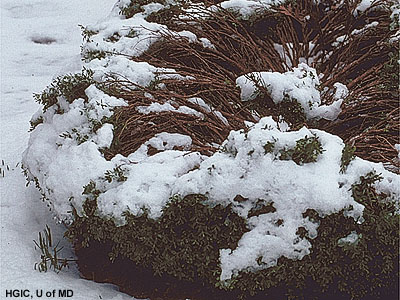Preventing Winter Damage to Woody Plants
by Gretchen Spencer, Fairfax Master Gardener

Boxwood under heavy snow
The winter solstice, the shortest day of the year, occurs on December 21st and ushers in the first official day of winter. The winters in the DC area bring varying amounts of snow, ice, wind, and below freezing temperatures. We can have a mild winter with as little as a tenth of an inch of snow or a Snowmageddon winter with 56 inches of snow! Typically, most wintery weather falls in January and February. Even so, after December 21st, the days will gradually begin to lengthen!
With winter weather soon here, there are some things a gardener or homeowner can do to prevent winter damage to trees and shrubs. One of the most important preventative measures is to make sure to select plants that are hardy in our area (Hardiness zones 7A/B). Planting the “right plant in the right place” is key to success!
General Cultural Practices
- Maintain a two-inch layer of mulch around small trees and shrubs to help them retain moisture and protect their roots from fluctuating temperatures. This is especially beneficial for shallow rooted plants such as azaleas, boxwoods, camellias, viburnums, and hydrangeas.
- Avoid pruning or fertilization in the fall as it can stimulate growth that is easily damaged by freezing temperatures.
- Water in the fall or on mild winter days, especially during dry periods, by soaking the soil several inches deep around the plant. This helps to encourage deeper rooting and to prevent winter desiccation or winter burn.
Snow and Ice
 While the snow totals in our area vary greatly from year to year, our average snow total is about 15 inches. On the positive side, snow cover insulates the roots of trees and shrubs and helps to moderate temperature fluctuations that can damage roots. However, heavy wet snow can damage trees, shrubs, and evergreens.
While the snow totals in our area vary greatly from year to year, our average snow total is about 15 inches. On the positive side, snow cover insulates the roots of trees and shrubs and helps to moderate temperature fluctuations that can damage roots. However, heavy wet snow can damage trees, shrubs, and evergreens.
- Use a broom to gently remove snow from shrubs and branches by brushing upward before it becomes too heavy.
- Loosely wrap or tie the branches of evergreens such as yews, arborvitae, and junipers with strips of cloth or coated twine to prevent them from bending and breaking.
- Do not try to remove ice from shrubs or trees as ice-covered branches are brittle and will break.
Wind and Fluctuating Winter Temperatures
Fluctuations in winter temperatures such as a rapid drop in temperature after a warm sunny day as well as drying winter winds can cause winter burn or desiccation on both narrow-leafed and broad-leafed evergreens. This winter injury causes needles and leaves to lose moisture and turn brown and appear scorched. Additionally, frost cracks or sun scald may appear on tree trunks caused by sudden or extreme drop in temperatures after a sunny day has warmed the bark. This occurs mostly on the south or southwest side of trees where sun exposure is prolonged.
- Watering on warm winter days and keeping shrubs mulched helps to prevent winter burn.
- Protecting boxwoods and other small evergreens with windbreaks made out of canvas or burlap can prevent water loss.
- Applying an anti-desiccant spray may help to minimize damage to leaves and needles.
Road Salt Damage to Plants
Trees and shrubs can be easily injured by the use of de-icing salts on roads and sidewalks. Browning evergreens, dying branches, scorched leaves, and dead areas in the lawn can be caused by de-icing salts.
- Use sand, sawdust, or non-chemical de-icing compounds that are safe for plants and pets.
- When planting near roads, select trees or shrubs that are salt tolerant such as white oak, honey locust, red oak, junipers, or roses.

Deer have dined extensively on this row of arborvitae — its needles will not grow back
Animal Damage
Mice, rabbits, and deer can all cause damage to plants in the winter, especially in severe winters when food is scarce. Mice and rabbits can chew the bark of young trees or shrubs. Deer can also eat the leaves and branches of young shrubs or trees as well as rub their antlers on young tree trunks, stripping the branches off. This has happened to this author several times!
- Pull mulch away from the base of trees can help to deter mice.
- Apply mouse, rabbit, and deer repellant to trees and shrubs.
- Protect young trees from deer with chicken wire cages or fences.
In spite of all the challenges that winter weather can bring to trees and shrubs, homeowners, and gardeners, winter provides trees and shrubs with the dormant period they need to rest during the cold and snowy months. Even though the winter months are still ahead of us, Oliver Herford’s poem “I Heard a Bird Sing” is a gentle reminder of what is to come.
I heard a bird sing
In the dark of December.
A magical thing
And sweet to remember.“We are nearer to Spring
Than we were in September.”
I heard a bird sing
In the dark of December.
References
Winter Damage on Landscape Plants, University of Maryland Extension
Winter Damage, Mahfuz Rahman, West Virginia University Extension Service
Managing Winter Injury to Trees and Shrubs, Virginia Cooperative Extension
… updated 2022